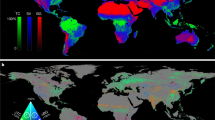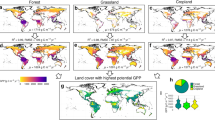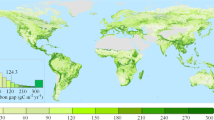Abstract
Humanity has become a major player within the Earth system, particularly by transforming large parts of the land surface and by altering the gaseous composition of the atmosphere. Deforestation for agricultural purposes started thousands of years ago and might have resulted in a detectable human influence on climate much earlier than the industrial revolution. This study presents a first attempt to estimate the impact of human land-use on the global carbon cycle over the last 6,000 years. A global gridded data set for the spread of permanent and non-permanent agriculture over this time period was developed and integrated within the Lund-Potsdam-Jena Dynamic Global Vegetation Model (LPJ-DGVM). The model was run with and without human land-use, and the difference in terrestrial carbon storage was calculated as an estimate of anthropogenic carbon release to the atmosphere. The modelled total carbon release during the industrial period (a.d. 1850–1990) was 148 gigatons of carbon (GtC), of which 33 GtC originated from non-permanent agriculture. For pre-industrial times (4000 b.c.–a.d. 1850), the net carbon release was 79 GtC from permanent agriculture with an additional 35 GtC from non-permanent agriculture. The modelled pre-industrial carbon release was considerably lower than would be required for a substantial influence on the climate system.





Similar content being viewed by others
References
Anderson RC (1987) The historic role of fire in the North American grassland. In: Collins SL, Wallace LL (eds) Fire in North American Tallgrass Prairies. University of Oklahoma Press, Norman, pp 9–18
Bondeau A, Smith P, Zaehle S, Schaphoff S, Lucht W, Cramer W, Gerten D, Lotze-Campen H, Müller C, Reichstein M, Smith B (2007) Modelling the role of agriculture for the 20th century global terrestrial carbon cycle. Glob Change Biol 13:679–706
Brady NC (1996) Alternatives to slash-and-burn: a global imperative. Agric Ecosyst Environ 58:3–11
Broecker WS, Stocker TF (2006) The Holocene CO2 rise: anthropogenic or natural? EOS 87:27–29
Brovkin V, Bendtsen J, Claussen M, Ganopolski A, Kubatzki C, Petoukhov V, Andreev A (2002) Carbon cycle, vegetation and climate dynamics in the Holocene: experiments with the CLIMBER-2 model. Global Biogeochem Cycles 16:1139, 10.1029/2001GB001662
Brovkin V, Claussen M, Driesschaert E, Fichefet T, Kicklighter D, Loutre MF, Matthews HD, Ramankutty N, Schaeffer M, Sokolov A (2006) Biogeophysical effects of historical land cover changes simulated by six Earth system models of intermediate complexity. Clim Dyn 26:587–600. doi:10.1007/s00382-005-0092-6
Campos CP, Muylaert MS, Rosa LP (2005) Historical CO2 emission and concentrations due to land use change of croplands and pastures by country. Sci Total Environ 346:149–155
Carcaillet C, Almquist H, Asnong H, Bradshaw RHW, Carrión JS, Gaillard M-J, Gajewski K, Haas JN, Haberle SG, Hadorn P, Müller SD, Richard PJH, Richoz I, Rösch M, Sánchez Gõni MF, Stedingk H von, Stevenson AC, Talon B, Tardy C, Tinner W, Tryterud E, Wick L, Willis KJ (2002) Holocene biomass burning and global dynamics of the carbon cycle. Chemosphere 49:845–863
Clark JS, Merkt J, Müller H (1989) Post-glacial fire, vegetation, and human history on the Northern alpine forelands, South-Western Germany. J Ecol 77:897–925
Crutzen PJ, Andreae MO (1990) Biomass burning in the tropics: impact on atmospheric chemistry and biogeochemical cycles. Science 250:1669–1678
DeFries RS, Field CB, Fung I, Collatz GJ, Bounoua L (1999) Combining satellite data and biogeochemical models to estimate global effects of human-induced land cover change on carbon emissions and primary productivity. Global Biogeochem Cycles 13:803–815
Diamond J (1997) Guns, germs and steel—a short history of everybody for the last 13000 years. Chatto and Windus, London
FAO (Food, Agriculture Organization) (1991) The digitized soil map of the world (release 1.0). FAO, Rome
Fearnside PM (2000) Global warming and tropical land-use change: greenhouse gas emissions from biomass burning, decomposition and soils in forest conversion, shifting cultivation and secondary vegetation. Clim Change 46:115–158
Foley JA, Costa MH, Delire C, Ramankutty N, Snyder P (2003) Green surprise? How terrestrial ecosystems could affect earth’s climate. Front Ecol Environ 1:38–44
Foley JA, DeFries R, Asner GP, Barford C, Bonan G, Carpenter SR, Chapin FS, Coe MT, Daily GC, Gibbs HK, Helkowski JH, Holloway T, Howard EA, Kucharik CJ, Monfreda C, Patz JA, Prentice IC, Ramankutty N, Snyder PK (2005) Global consequences of land use. Science 309:570–574
Gerten D, Schaphoff S, Haberlandt U, Lucht W, Sitch S (2004) Terrestrial vegetation and water balance—hydrological evaluation of a dynamic global vegetation model. J Hydrol 286:249–270
Giardina CP, Sanford RL, Døckersmith IC, Jaramillo VJ (2000) The effects of slash burning on ecosystem nutrients during the land preparation phase of shifting cultivation. Plant Soil 220:247–260
Gupta AK (2004) Origin of agriculture and domestication of plants and animals linked to early Holocene climate amelioration. Curr Sci India 87:54–59
Hickler T, Prentice IC, Smith B, Sykes MT, Zaehle S (2006) Implementing plant hydraulic architecture within the LPJ Dynamic Global Vegetation Model. Global Ecol Biogeogr 15:567–577
Houghton RA (1999) The annual net flux of carbon to the atmosphere from changes in land use 1850–1990. Tellus 51B:298–313
Houghton RA (2003) Revised estimates of the annual net flux of carbon to the atmosphere from changes in land use and land management 1850–2000. Tellus 55B:378–390
Houghton RA, Goodale CL (2004) Effects of land-use change on the carbon balance of terrestrial ecosystems. In: De Fries R, Asner G, Houghton R (eds) Ecosystems and land use change. American Geophysical Union, Washington DC, pp 85–98
Houghton RA, Hobbie JE, Melillo JM, Moore B, Peterson BJ, Shaver GR, Woodwell GM (1983) Changes in the carbon content of terrestrial biota and soils between 1860 and 1980: a net release of CO2 to the atmosphere. Ecol Monogr 53:235–262
Indermühle A, Stocker TF, Joos F, Fischer H, Smith HJ, Wahlen M, Deck B, Mastroianni D (1999) Holocene carbon-cycle dynamics based on CO2 trapped in ice at Taylor Dome, Antarctica. Nature 398:121–126
Joos F, Gerber S, Prentice IC, Otto-Bliesner BL, Valdes PJ (2004) Transient simulations of Holocene atmospheric carbon dioxide and terrestrial carbon since the Last Glacial Maximum. Global Biogeochem Cycles 18:GB2002, 10.1029/2003GB002156
Kaplan JO, Prentice IC, Knorr W, Valdes PJ (2002) Modeling the dynamics of terrestrial carbon storage since the Last Glacial Maximum. Geophys Res Lett 29, DOI 10.1029/2002GL015230
Klein Goldewijk K (2001) Estimating global land use change over the past 300 years: the HYDE Database. Global Biogeochem Cycles 15:417–433
Köhler P, Fischer H (2004) Simulating changes in the terrestrial biosphere during the last glacial/interglacial transition. Glob Planet Change 43:33–55
Lal R (2003) Soil erosion and the global carbon budget. Environ Int 29:437–450
Lanly JP (1985) Defining and measuring shifting cultivation. Unasylva 37:17–21
Levy PE, Friend AD, White A, Cannell MGR (2004) The influence of land use change on global-scale fluxes of carbon from terrestrial ecosystems. Clim Change 67:185–209
Lewthwaite JW, Sherratt A (1980) Chronological atlas. In: Sherratt A (ed) Cambridge encyclopedia of archeology. Cambridge University Press, Cambridge, pp 437–452
Lucht W, Prentice IC, Myneni RB, Sitch S, Friedlingstein P, Cramer W, Bousquet P, Buermann W, Smith B (2002) Climatic control of the high-latitude vegetation greening trend and Pinatubo effect. Science 296:1687–1689
Malhi Y, Meir P, Brown S (2002) Forests, carbon and global climate. Philos T R Soc B 360:1567–1591
McEvedy C, Jones R (1978) Atlas of world population history. Facts on File, New York, pp 342–351
McGuire AD, Sitch S, Clein JS, Dargaville R, Esser G, Foley J, Heimann M, Joos F, Kaplan J, Kicklighter DW, Meier RA, Melillo JM, Moore III B, Prentice IC, Ramankutty N, Reichenau T, Schloss A, Tian H, Williams LJ, Wittenberg U (2001) Carbon balance of the terrestrial biosphere in the twentieth century: analysis of CO2, climate and land use effects with four process-based ecosystem models. Global Biogeochem Cycles 15:183–206
Metzger JP (2003) Effects of slash-and-burn fallow periods on landscape structure. Environ Conserv 30:325–333
Monnin E, Steig EJ, Siegenthaler U, Kawamura K, Schwander J, Stauffer B, Stocker TF, Morse DL, Barnola J-M, Bellier B, Raynaud D, Fischer H (2004) Evidence for substantial accumulation rate variability in Antarctica during the Holocene, through synchronization of CO2 in the Taylor Dome, Dome C and DML ice cores. Earth Planet Sci Lett 224:45–54
New M, Hulme M, Jones PD (1999) Representing twentieth-century space–time climate variability. Part I: development of a 1961–90 mean monthly terrestrial climatology. J Clim 12:829–856
New M, Hulme M, Jones PD (2000) Representing twentieth-century space–time climate variability. Part II: development of 1901–96 monthly grids of terrestrial surface climate. J Clim 13:2217–2238
Petit JR, Jouzel J, Raynaud D, Barkov NI, Barnola J-M, Basile I, Bender M, Chappellaz J, Davisk M, Delaygue G, Delmotte M, Kotlyakov VM, Legrand M, Lipenkov VY, Lorius C, Pépin L, Ritz C, Saltzmank E, Stievenard M (1999) Climate and atmospheric history of the past 420,000 years from the Vostok ice core, Antarctica. Nature 399:429–436
Prentice IC, Farquhar GD, Fasham MJ, Goulden MI, Heimann M, Jaramillo VJ, Kheshgi HS, LeQuéré C, Scholes RJ, Wallace DWR (2001) The carbon cycle and atmospheric CO2. In: Houghton JT, Ding Y, Griggs D, Noguer M, van der Linden P, Dai X, Maskell K, Johnson CA (eds) Climate change 2001: the scientific basis (contribution of working group I to the third assessment report of the intergovernmental panel on climate change). Cambridge University Press, Cambridge, pp 183–237
Roberts N (1998) The Holocene: an environmental history. Blackwell, Oxford
Ruddiman WF (2003) The anthropogenic greenhouse era began thousands of years ago. Clim Change 61:261–293
Ruddiman WF (2005) The early anthropogenic hypothesis a year later. Clim Change 69:427–434
Ruddiman WF, Thomson JS (2001) The case for human causes of increased atmospheric CH4 over the last 5000 years. Q Sci Rev 20:1769–1777
Sherratt A (1980) The Cambridge encyclopedia of archaeology. Cambridge University Press, Cambridge
Siegenthaler U, Stocker TF, Monnin E, Lüthi D, Schwander J, Stauffer B, Raynaud D, Barnola J-M, Fischer H, Masson-Delmotte V, Jouzel J (2005) Stable carbon cycle–climate relationship during the late Pleistocene. Science 310:1313–1317
Simmons IG (1996) Changing the face of the earth: culture, environment, history. Blackwell, Oxford
Sitch S, Smith B, Prentice IC, Arneth A, Bondeau A, Cramer W, Kaplan JO, Levis S, Lucht W, Sykes MT, Thonicke K, Venevsky S (2003) Evaluation of ecosystem dynamics, plant geography and terrestrial carbon cycling in the LPJ dynamic global vegetation model. Glob Change Biol 9:161–185
Turner BL II, Clark WC, Kates RW, Richards JF, Mathews JT, Meyer WB (eds) (1990) The earth as transformed by human action. Cambridge University Press, Cambridge
Vitousek PM, Mooney HA, Lubchenco J, Melillo JM (1997) Human domination of Earth’s ecosystems. Science 277:494–499
Williams M (2000) Dark ages and dark areas: global deforestation in the deep past. J Hist Geogr 26:28–46
Williams M (2003) Deforesting the earth: from prehistory to global crisis. University of Chicago Press, Chicago
Zobler L (1986) A world soil file for global climate modelling. NASA Technical Memorandum, 87802, 32
Acknowledgements
We thank Paul Miller for proofreading the manuscript and for giving valuable comments. The CRU05 climate data were supplied courtesy of the Climatic Research Unit, University of East Anglia.
Author information
Authors and Affiliations
Corresponding author
Additional information
Communicated by M.-J. Gaillard.
Rights and permissions
About this article
Cite this article
Olofsson, J., Hickler, T. Effects of human land-use on the global carbon cycle during the last 6,000 years. Veget Hist Archaeobot 17, 605–615 (2008). https://doi.org/10.1007/s00334-007-0126-6
Received:
Accepted:
Published:
Issue Date:
DOI: https://doi.org/10.1007/s00334-007-0126-6




